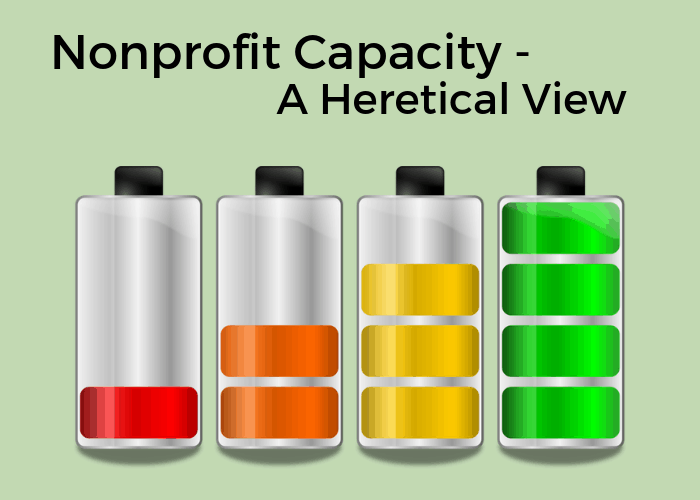
Nonprofit Capacity Building – A Heretical View
Capacity building doesn’t work. It’s a waste of time, money and energy. There… we said it… sorry foundations and all your capacity building money… sorry nonprofits and all your capacity building grants.
First, capacity building in the nonprofit sector is a misnomer. The concept germinated in the international development world. It refers to helping communities (countries) own, resource, and sustain their own development (US AID) or refers to an investment in people, institutions, and practices that will, together, enable countries … to achieve their development objective (World Bank). The generic use of the term in the nonprofit sector refers to building the skills, knowledge, tools, or resources to improve organizational performance. As such, it defaults to information, education or training, or more money, more staff, and more tools.
Nonprofit capacity building doesn’t work because it is built on the premise that “if we just had more, it will be better.” However,
- More, newer, or bigger capacity isn’t necessarily better. It’s just more, newer, or bigger. More money and more staff in a dysfunctional, inefficient or ineffective organization, just exacerbates the dysfunction and increases the inefficiencies.
- Capacity building is usually tactical. A tactical approach often undermines critical analysis to define the root cause and to challenge prevailing assumptions. For example, organizations may institute great training programs, but if there is high turnover, the training program is money down the drain. And, a root cause analysis is likely to show that lack of training is not the reason for turnover!
- Capacity building is often added-on, separate from the organization’s larger context, mission, programs, and constituents. It focuses on one or two aspects of capacity at a time, thus neglecting the reality of the organization as a system. Change in one part of the system impacts all the other parts and traditional capacity building doesn’t take these ripple effects into account. For example, the new customer relationship management software is a capacity-building resource, but if the organization doesn’t have a constituent-centered mindset throughout the organization, it is a useless tool.
Of course, nonprofit organizations need capacity! But the more appropriate and accurate term comes from the discipline of organizational behavior, also called organizational management. The literature, practices, and principles of organizational behavior provide the body of knowledge and practice for organizational development. Thus, organization development is the more true and accurate term, associated with a specific discipline.
In Organizational Behavior and Management, Ivancevich and Mattson define organizational development as a “planned effort to improve an organization’s operations through more effective utilization of organizational resources.” It is a deliberate and systematic approach to develop organizational structures, systems, and practices to achieve outcomes and build a supportive and inclusive culture.
Organizational development (O.D.) is exactly pertinent to the development of nonprofit organizations. It focuses on understanding and managing individual behavior, how people behave in groups and group dynamics, and organizational processes including, for example, leadership, decision making, and communication. In short, organizational development is the more appropriate approach because it addresses the components of capacity within an organizational (systems) context: individuals influence groups influence organizations.


